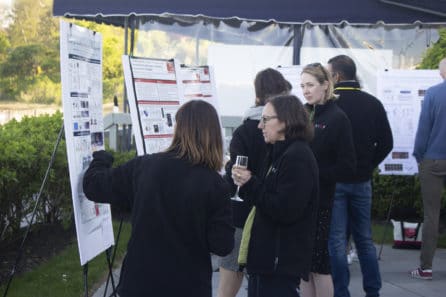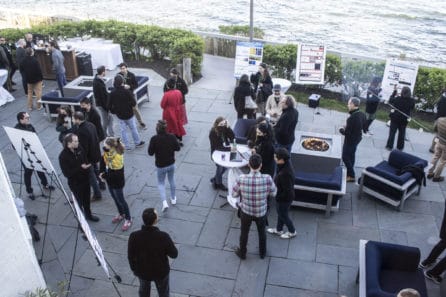Science by the Sea: Highlights of the NYSCF Innovators Retreat
NewsThis month, the NYSCF – Robertson Investigators, NYSCF – Druckenmiller Fellows, and NYSCF Research Institute scientists gathered (in-person for the first time in two years) in Montauk for the annual Innovators Retreat: a week of camaraderie, collaboration, and groundbreaking science.
Apply for the 2023 Investigator Awards here
“One of our core tenets at NYSCF has always been the belief in team science,” remarked NYSCF CEO Susan L. Solomon, JD. “We strive to advance research, technology, and programs that accelerate all research towards the clinic. Time and time again we have seen the magic that happens when we get our community ‘brain trust’ together — sharing new ideas, troubleshooting problems, and even sparking transformational collaborative research projects.”
“It’s always inspiring to see people at the top of their respective fields coming together to present their work, get feedback from their peers, and form new connections,” added Richard Ha, NYSCF’s Director of External Programs. “The science that this retreat makes possible is so transformative, and it’s a true testament to the power of bringing great minds together.”
“I received the NYSCF – Robertson Stem Cell Investigator Award back in 2011, and I believe this award really frees scientists at a point in our careers where we have so many ideas and are inspired to change the world, but our labs are just starting up and we have to spend a lot of time on other things,” noted Paola Arlotta, PhD, NYSCF’s Scientific Advisor and Chair of the Department of Stem Cells and Regenerative Biology at Harvard.
“With this award, you can take big risks and pursue ideas that could really change the field, which is how science should always be done. When I was asked to join NYSCF as an advisor to the program, I didn’t hesitate for a second. I love being a part of this community, and the energy it brings to the field.”
Tackling Today’s Biggest Questions
The NYSCF Innovators are at the forefront of pioneering disease research, and they shared many exciting updates on studies that are paving the way for better outcomes for patients.
NYSCF – Robertson Stem Cell Investigator Louis Vermuelen, MD, PhD, of Academic Medical Center in Amsterdam studies the role of stem cells in colorectal cancer development and progression.
“The intestine is a huge organ – the surface area is nearly the size of a tennis court,” he explained. “It renews every 7 days, and is home to some of the most common cancers that are most difficult to treat.”
Dr. Vermuelen’s lab has found how mutant cells overpower their neighbors to drive colon cancer, and has even launched a clinical trial to test whether lithium drugs can prevent colon cancer in genetically predisposed patients.
NYSCF – Robertson Neuroscience Investigator Lindy McBride, PhD, of Princeton University studies how mosquitos spread disease.
“Mosquitos are the world’s deadliest animal, killing roughly 725 thousand per year [by carrying disease],” she said. “Even though there are 3,000 different species, it’s just a handful who have a preference for biting humans.
Her latest study examines what makes us smell tasty to a mosquito and how we might be able to stop them from sniffing us out.
One of the nation’s biggest health issues pertains to the opioid crisis – and NYSCF – Robertson Neuroscience Investigator Greg Scherrer, PhD, PharmD, of the University of North Carolina at Chapel Hill, shared his work to understand the neural basis behind pain and develop safer, non-addictive medications.
“We want to understand how the cells in our nervous system give rise to the multiple dimensions of pain,” he said. “If we do a good job of uncovering these mechanisms, then we can hopefully find new ways to treat pain, which is highly needed.”
Ever wonder why stress can make your hair fall out or turn gray? NYSCF – Robertson Stem Cell Investigator Ya-Chieh Hsu, PhD, has an answer for you. Her lab at Harvard used stem cells to discover how stress can affect the cells that create new hair and give it its pigment.
“Understanding how our tissues change under stress is the first critical step toward eventual treatment that can halt or revert the detrimental impact of stress,” she remarked. “We still have a lot to learn in this area.”

The retreat also featured a poster session where early career researchers, including the NYSCF – Druckenmiller Fellows, shared their latest findings from applying stem cells to a wide range of diseases like Alzheimer’s, Parkinson’s, cancer, diabetes, and more.
Fostering Diversity, Equity, Inclusion, and Belonging (DEIB) in STEM
The retreat also featured a session focused on advancing DEIB in the scientific community, including breakout discussions on key topics: mentorship, lab- and team-centric activities, institutional initiatives/policies, and review processes for grantmaking and faculty searches.
“Racism and other inequities create open/closed signs in our society, leading to unfair advantages and disadvantages,” noted NYSCF Vice President of Scientific & DEIB Outreach Raeka Aiyar, PhD. “We all know that it is critical to overcome these barriers to achieve the most productive, innovative, and collaborative workforce possible.”
“The good news is that we have more momentum than ever to take this on as a community. We wanted to use the opportunity of being back in person to brainstorm strategies for promoting DEIB throughout the STEM field, so that everyone has the opportunity to innovate and collaborate.”
In an hour of discussions, participants highlighted several topics, ranging from regular DEIB-focused journal clubs, to creating safe, communicative environments in mentor-mentee relationships, to collecting key benchmarking data that will help us to understand which interventions have an impact.
“In review processes, we need to look beyond our traditional definitions of academic productivity to include things like lived experience and advocacy,” noted NYSCF – Robertson Stem Cell Investigator José Ordovás-Montañés, PhD, of Boston Children’s Hospital. “It’s not just about the publications, but the way the publications came about.”
Science is a Team Sport
One of the most exciting aspects of the retreat is the collaborations formed between members of the NYSCF community. Scientists shared promising updates on a few of these partnerships and what to expect next.
For example, NYSCF – Robertson Neuroscience Investigators Ilana Witten, PhD, and Annegret Falkner, PhD (both at Princeton University) shared how they are working together to examine how individual variability in behavior can predict outcomes for people with depression and anxiety.

NYSCF Senior Vice President of Discovery & Platform Development Daniel Paull, PhD, has similarly struck up a collaboration with NYSCF – Robertson Stem Cell Investigator Kristen Brennand, PhD, of the Icahn School of Medicine at Mount Sinai to study PTSD using human stem cells. Their work was recently accepted for publication (stay tuned!), and could help researchers identify markers in cells that are predictive of PTSD risk.
The retreat is unique in that it brings together stem cell scientists and neuroscientists to discuss many of each field’s biggest questions. Having people with different backgrounds and ways of thinking in the same room can give rise to new ideas and strategies that researchers might never have considered otherwise.
“NYSCF has been visionary in bringing together very diverse Investigators,” remarked NYSCF – Stem Cell Investigator Vikram Khurana, MD, PhD, of Brigham and Women’s Hospital and Harvard Medical School. “This forces us as scientists to rethink our strategies, reevaluate how we do our research, and opens the door for collaboration opportunities we wouldn’t otherwise have. Without question, the NYSCF retreat is the scientific high point of my year.”
“‘Innovator community’ is a very apt name, because this group is incredibly innovative in how they do science,” noted NYSCF – Robertson Stem Cell Investigator Samantha Morris, PhD, of Washington University School of Medicine. “At the retreat, I learn so much about areas that may be outside my immediate field, but that nonetheless teach me about how to think creatively and ask questions in a new way.”